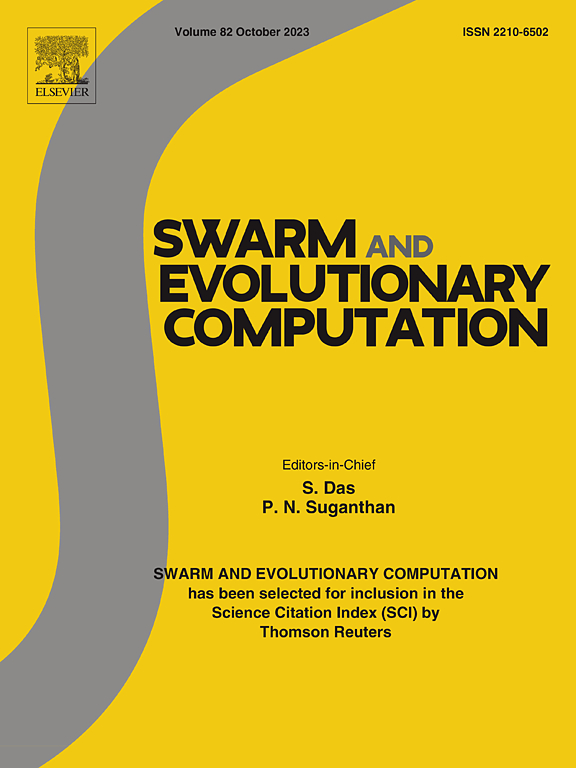高维昂贵多目标优化的回归与关系辅助进化算法
IF 8.5
1区 计算机科学
Q1 COMPUTER SCIENCE, ARTIFICIAL INTELLIGENCE
引用次数: 0
摘要
代理辅助进化算法(saea)在处理昂贵的多目标优化问题(EMOPs)方面得到了广泛的关注。然而,当涉及到高维EMOPs (HEMOPs)时,由于维度敏感性问题,现有的saea性能显著下降,难以建立有效的替代模型。为此,我们提出了一种回归和关系辅助进化算法(R2AEA)来处理HEMOPs,该算法包括回归辅助权重优化(RWO)阶段和关系辅助多目标优化(RMO)阶段。具体来说,RWO是由问题转换策略和回归模型促进的。它将高维问题转化为相对低维问题,并试图有效地收敛到pareto最优前沿(PF)。在此基础上,采用一种新的填充采样准则来保持种群多样性,该准则既考虑了预测熵估计的不确定性,又考虑了优化性能。为了验证其有效性,我们将R2AEA与五种最先进的算法在不同的基准测试套件(尺寸从50到200不等)和六个现实世界的HEMOPs中进行了比较。实验结果表明,在有限的计算资源下,R2AEA在收敛速度和多样性维护方面具有优势。本文章由计算机程序翻译,如有差异,请以英文原文为准。
Regression and relation-assisted evolutionary algorithm for high-dimensional expensive multi-objective optimization
Surrogate-assisted evolutionary algorithms (SAEAs) have gained a lot of attention to handle expensive multi-objective optimization problems (EMOPs). However, when it comes to high-dimensional EMOPs (HEMOPs), the performance of existing SAEAs degrades dramatically because of the dimensionality sensitivity issue, in which effective surrogate models are difficult to build. To this end, we propose a regression- and relation-assisted evolutionary algorithm () to deal with HEMOPs, which involves a regression-assisted weight optimization (RWO) stage and a relation-assisted multi-objective optimization (RMO) stage. To be specific, the RWO is facilitated by the problem transformation strategy and regression models. It reformulates the high-dimensional problem into a relative low-dimensional one and intends to converge to the Pareto-optimal front (PF) efficiently. Thereafter, the RMO concentrates on maintaining the population diversity with a new infill sampling criterion, which considers the optimization performance as well as the uncertainty estimated by the predicted entropy. To validate its effectiveness, we compare with five state-of-the-art algorithms on various benchmark test suites with dimensions varying from 50 to 200, and six real-world HEMOPs. Experimental results show the superiority of in terms of convergence speed and diversity maintenance with limited computational resources.
求助全文
通过发布文献求助,成功后即可免费获取论文全文。
去求助
来源期刊

Swarm and Evolutionary Computation
COMPUTER SCIENCE, ARTIFICIAL INTELLIGENCEC-COMPUTER SCIENCE, THEORY & METHODS
CiteScore
16.00
自引率
12.00%
发文量
169
期刊介绍:
Swarm and Evolutionary Computation is a pioneering peer-reviewed journal focused on the latest research and advancements in nature-inspired intelligent computation using swarm and evolutionary algorithms. It covers theoretical, experimental, and practical aspects of these paradigms and their hybrids, promoting interdisciplinary research. The journal prioritizes the publication of high-quality, original articles that push the boundaries of evolutionary computation and swarm intelligence. Additionally, it welcomes survey papers on current topics and novel applications. Topics of interest include but are not limited to: Genetic Algorithms, and Genetic Programming, Evolution Strategies, and Evolutionary Programming, Differential Evolution, Artificial Immune Systems, Particle Swarms, Ant Colony, Bacterial Foraging, Artificial Bees, Fireflies Algorithm, Harmony Search, Artificial Life, Digital Organisms, Estimation of Distribution Algorithms, Stochastic Diffusion Search, Quantum Computing, Nano Computing, Membrane Computing, Human-centric Computing, Hybridization of Algorithms, Memetic Computing, Autonomic Computing, Self-organizing systems, Combinatorial, Discrete, Binary, Constrained, Multi-objective, Multi-modal, Dynamic, and Large-scale Optimization.
 求助内容:
求助内容: 应助结果提醒方式:
应助结果提醒方式:


